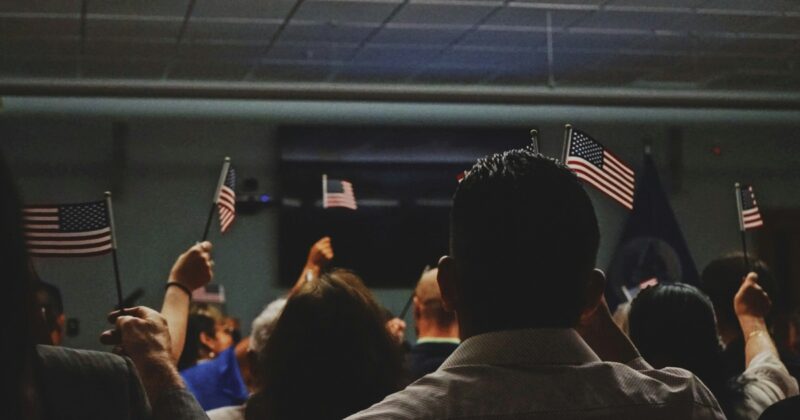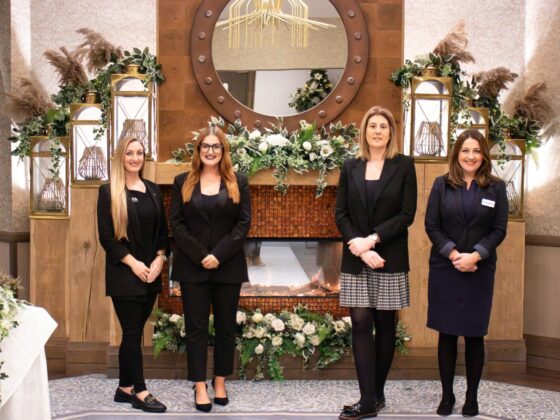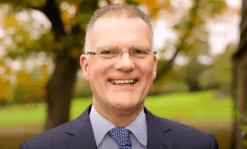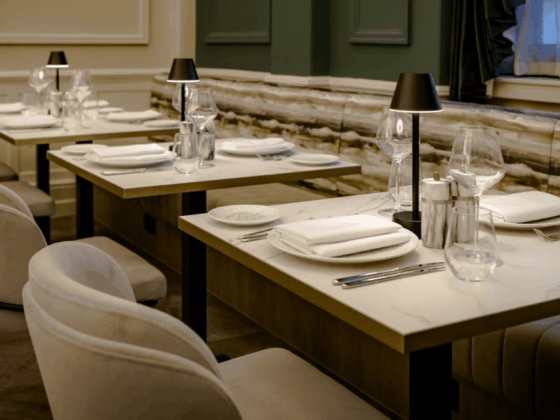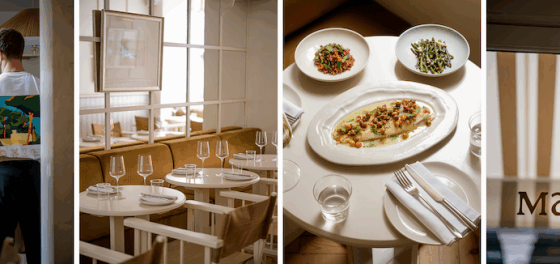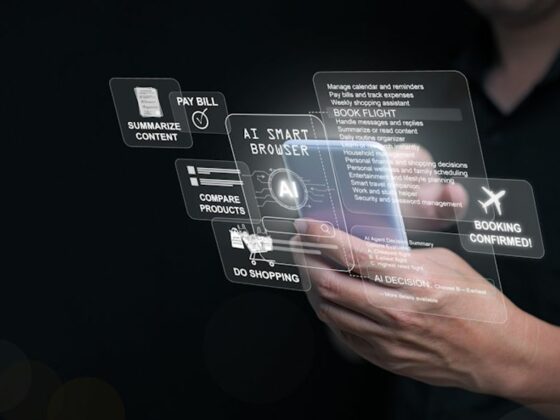Dina: We’ll never have kiosks in our lobby because we actually want to talk to the guests and interact with them and learn about them and understand what their needs are. But we’re very tech-forward behind the scenes. So we’re launching our new tech stack. Currently, we’re in the middle of it. We’re switching over to Mews as our PMS system and Thynk as our CRM. And then we’ve added Optii for our housekeeping. And they’ll be some more tech stack changes coming after this first wave, but that really gives us the ability to help the team members that are on the front line trying to deliver that hyper-personalized service, the knowledge and the information that they need to be able to do it. In the future, we will be getting rid of all of our front desks and going to iPads and completely off of a more traditional model after we get our technology in place and everything’s kind of smooth and running well. We’re really excited about that. We think that’s going to be one of the key factors that’s going to help us really elevate that ability to provide that kind of service level. giving the team that information at their fingertips about you, that your dog is Susie and she always comes when you visit, even though you’ve never stayed at the Maxwell, you’ve only stayed at our hotel in San Francisco, The Maxwell, knows Susie as well and can say, Oh, John at San Francisco that you talk to all the time told me that Susie comes and milk bones are her favorite treats. and she doesn’t like soft ones, she only likes hard ones, so we made sure we have them, and they’re in your room already, and please enjoy your stay.” That is the kind of service level we’re wanting to provide our guests, and that is what gets those accolades. That is what blows people’s mind.
Josiah: I wonder if I could get your perspective on how you knew it was time to make a change because my background’s in technology and sometimes I see new technology, I just get excited because it’s new. You have deep operational expertise. You’re president of the company of a portfolio that spans the country. How did you know from your perspective something needed to change here?
Dina: Yeah, we’ve been using the same operating system since our inception. So, we are not a hop-on-new technology company. It was a huge decision for us to change, particularly our PMS system, which is our core technology.
Josiah: When you say the core, do you mean that’s sort of like a hub, and then everything plugs into that or kind of feeds off of that?
Dina: I would actually reverse my statement. What we actually use as the core of our technology solution is Thynk, which is overlaid on Salesforce, right? So it’s our CRM, our customer information, and everything that the team members have at their disposal to help elevate that experience in Thynk. And then Thynk communicates to Mews so that the front line can understand all of that information because they’re using Mews, right? What’s in front of them every day is Mews, but the two applications are synced to each other. We do use Thynk as our real brain, right? It’s the brain of the operation. It’s where all of the information is held and is the center point. And then a lot of applications feed into Thynk within the organization. Our sales and catering team uses Thynk. Everybody is kind of tapped into that solution. And you’ll see in everything I talk about, the guest and the guest’s information is at the center of everything that we do. So whether it’s a human resources process, our technology solutions, the process we use at the hotels, or the fact that we have centralized services, everything is really based around the central premise that the guest is at the center of everything that we’re working on. I know everybody says that. Again, we’ve said that, right? Everybody says that.
Josiah: But everyone says that you’re doing it differently. You actually did something about it because as you’re describing that tech stack, most hotels don’t operate that way. And so was the, I guess what initiated this whole process, and it sounds like a guiding North Star was the guest, right? And then did you almost sort of visualize this ideal guest experience and then translate it. If that’s the North Star, I guess, how did you think about building out the program and deciding what technology partners you work with?
Dina: Yeah, it was a long, it took us about two years and we started with a guest experience journey project. So we really in-depth every department in the company from marketing to distribution to revenue management, even accounting, everybody was involved in identifying our perfect guest experience journey. Then we went out and asked how technology is going to help us deliver that premium guest experience journey. And then we went out to the market and said, let’s look at the technology solutions. And we RFP’d like everybody in the business and kind of started wide and narrowed down to a half a dozen and then looked at all of them, interviewed. I mean, it was an intensive project. It took us a long time and a lot of energy. And then we got really close to making a decision and stepped back again and went, We’re going down a path. We had selected a solution and it wasn’t quite what we wanted, but we were like, well, this is the best we can do. And the technology that we ended up selecting, Mews, had actually been eliminated fairly early on. because of some connectivity and API issues that we perceived. So we went back to kind of the final list of six again and said, I know we’ve already talked to you guys, but we just want to chat one more time and make sure that any of the issues that we had identified that eliminated you are actually real issues. And we determined that with Mews, we could overcome the connectivity issue that we had initially thought was a problem. And so we put them back into the fold and ended up changing our mind at really the ninth hour and saying, this is the right solution for us. And a lot of the reason, I mean, it’s obviously the technology and the actual product that they put out, but just as important for us, we’re a highly innovative company. It’s our culture to constantly be changing and evolving and innovating and doing the next best thing. trying to really elevate our processes and systems. And we needed a company that was philosophically aligned with that. And Mews very much culturally tied with us. They’re young, they’re innovative, they’re doing a lot of interesting things. They’re changing the way, again, they’re contrarian a bit. They’re changing the way the industry is looking at a PMS system. In our historical experience, our PMS system was the heart. It was the center point, right? It was the thing that all of our data was in, and everything was there, so we had to attach everything to the PMS. the PMS is really an accounting and an operational system. It’s not necessarily the best at being customer-centric. None of them are. And so our ability to add think and connect to Mews to think created a whole new way for us to function and think about how we can deliver a technology solution to the end users, which are the front desk and the operations team in the field. That’s the other thing that was super important for me was I said to the team, probably at every meeting, I think they got annoyed at me saying it, the end user is the most important person of the constituency that cares about this application. Our frontline team is what we always need to put in the forefront when we’re choosing the technology. They’re the ones that are going to be using it because they’re the ones that are going to be using it and they’re the ones that are going to be interacting with the guests and it either helping them or not helping them. And we ask a lot of our team members that we don’t call them front desk agents. They’re everything people because we run boutique hotels. They have to cover a lot of different roles. They literally, at one moment, may be making a latte or checking somebody in or helping them with their bags or, you know, getting their car parked or right. They are literally everything. And so the tech and our current technology solution. was not helping them do their job. It was hindering them from doing their job. How did you know that? They told us. It wasn’t hard to figure out. We got a lot of feedback about how the workflow in what we were asking. Again, we’re asking a lot. We’re asking a everything person to understand who you are, What you do on a regular basis when you come to stay at our hotels, we have a lot of repeat guests. We have an inordinate amount of what we call pineapple enthusiasts. So they stay at different properties for us to be able to understand them and be able to share that information across our portfolio and have John at the Maxwell know what Bob at Staypineapple New York knows was really challenging. We couldn’t get the information to communicate properly. And so what we really wanted them to do, our technology was not allowing.
Josiah: Interesting. So it seems a very comprehensive process. You used an RFP. A lot of organizations use RFPs. You said you did a lot of interviews too. What did that interview process look like?
Dina: Yeah, we did. We have a giant boardroom that can seat about 40 people at the table, and it was probably three-quarters full. The interview companies were probably a little intimidated because there were so many people in the room and we have a big giant screen at the end and They’d be up on the screen and we would just pepper them with questions. You know, you would have the CRM email person peppering them about how emails work.
Josiah: Is this the technology providers or these are clients of the- Yeah. Okay. Interesting. Okay.
Dina: Yeah. Yeah. The providers. And then we would have, we had two general managers on the group that was making the decision. So we’d have a GM, you know, asking about, really everything people experience and what that’s going to look like. And then it was just like boom, boom, boom, boom, boom, boom. And the ones that were innovative and creative rose to the top really quickly. It was really clear and easy to see The providers that were static and had, you know, have been around a long time and are great systems and are the right systems for a lot of hotel companies. There’s nothing wrong with them. They just weren’t right for us. The ones that got excited about our crazy antics or our wild questions or, why can’t we do this? Or how about that? And that would answer, well, we don’t do that today. right? And then they’d start brainstorming with us and get excited about what the possibility was. Those were the vendors that we were interested in talking to.
Josiah: So interesting, the selection process is fascinating, but then it sounds like you’re going through the implementation now, which is a whole different animal. What are you learning or have learned about doing an implementation process well? Because I think a lot of people are, they find selection challenging, but I hear a lot of folks, it’s actually the implementation where it gets really tough and maybe where success, it can become successful or it falls flat. So what have you learned so far in the process?
Dina: I think the most important thing is that we listen again, just like in the selection process, to the team that are the end users. So we, what we decided to do was we rolled it out to two of our 10 hotels pretty quickly, like within a week. We did two installations, boom, boom. And there were mistakes and stuff went wrong and billing got messed up and we had a lot of manual corrections that had to be done and we learned a lot. We didn’t over plan going into the first two. I mean, we planned, we had project plans and kind of a general idea what we were trying to do, but we didn’t We didn’t spend months trying to build out an implementation strategy that was just going to blow up anyway. It doesn’t matter. You can’t possibly think of everything prior to implementation. We took a couple of the properties that we knew the teams were super strong and could handle it. And the general managers were very strong. And we were like, okay, we’re going to throw this at you guys and you’re going to be the Guinea pigs. And we’re all going to be there. Right. Everybody was on site. There was lots of late hours. There was a lots of manual, like the first one we did, we imported all the guest reservations into the new system, but the people that were on property didn’t come in. So suddenly reservations that were coming in to check in were getting reserved into rooms that were already occupied. And so we had this mass scramble of trying to figure out the house and who was there, where were they at? So that was one of the, you know, clear, we were like, okay, make sure that we know who’s in house and that that data is put in before we flip the switch. So those are the things that we, we learned through the first hotels, first two hotels. And then we’re taking a two-month break. And now we’re going to do the really detailed implementation plan for the rest of the eight hotels. The other thing is that we used the vendor’s full services on the first two. So we had their team here. They had multiple people here. It was all hands on deck. As we move forward, we’re pulling them out of the process. The next one will be limited help. And then the final ones, our intent is we will learn and we’ll be able to implement all of this on our own.
Josiah: So that’s interesting. So you’re investing more upfront on services. You’re almost building these best practices. And this is where technology partners can be helpful, right? If you have seen this done well, you probably have learned from all these other organizations. You’re bringing that in early as opposed to like sometimes things go wrong and then you end up spending the money after the fact. It’s a mess.
Dina: Exactly, exactly. And in the end, once we get through 10 hotels, we’ll have this down, we’ll know how to do it. We can do it internally, which reduces the cost upfront a lot of implementing a new PMS and new CRM system for our future owners as we grow and license and manage to other hotels. It was also a very important part of the selection process that we could roll out a cost-effective tech stack solution to new owners. Because we don’t want to be operating on multiple PMS and CRM systems. We think it’s very important as part of our really strategy around centralized services and keeping costs efficient or costs down and efficiency high is to have one tech stack and not have five different PMS systems that we’re trying to manage that becomes unwieldy.

